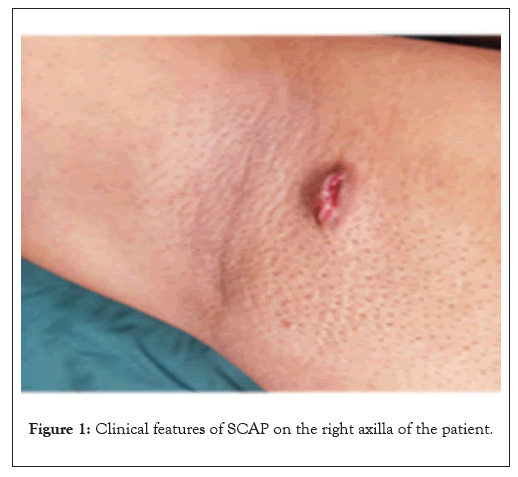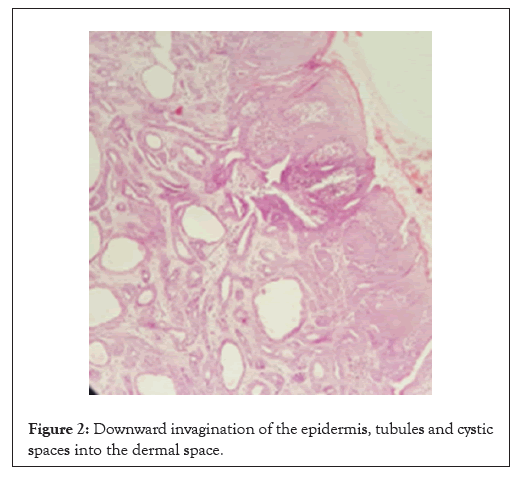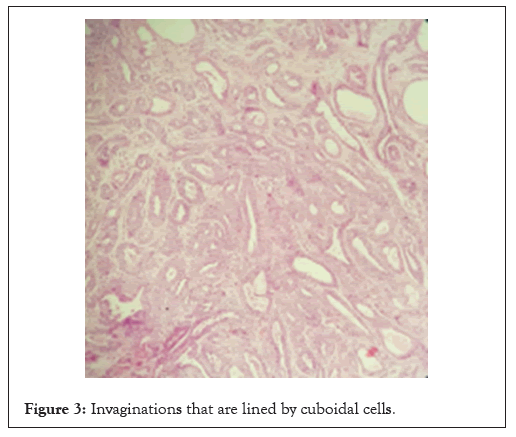Journal of Tumor Research
Open Access
ISSN: 2684-1258
ISSN: 2684-1258
Case Report - (2023)Volume 9, Issue 4
Syringocystadenoma Papilliferum (SCAP) has long remained an enigmatic entity within the realm of dermatology. Typically manifesting in familiar locales such as the neck, face, and scalp, SCAP has been intricately woven into the medical consciousness as a rare and benign hamartoma. However, our case report introduces an exceptional narrative that challenges convention. In an unexpected departure from the norm, we present the case of a 29-year- old adult male with SCAP in the axilla—an atypical locale. Lacking the customary association with nevus sebaceous, this case defies traditional expectations. The patient's journey began with a tender, erythematous nodule, ultimately unveiling an extraordinary histopathological composition. Histological analysis revealed an intricate canvas of dilated ducts, squamous differentiation, horn cyst formation, and a chorus of lymphoplasmacytic cells. Remarkably, the protagonist remained devoid of malignant or atypical elements, reaffirming its benign nature. This atypical presentation of SCAP in an adult male highlight its exceptional nature, challenging clinical acumen and beckoning histological scrutiny. It adds a unique chapter to the world of dermatopathology, shedding light on diagnostic intricacies. As the curtain falls on this case, it contributes to the ever-evolving tapestry of understanding in the intricate world of dermatopathology, enriching the medical narrative and offering valuable insights into an enigmatic dermatological puzzle.
Syringocystadenoma papilliferum; Atypical presentation; Hamartoma; Histopathology; Nevus sebaceous; Surgical excision; Metaplasia; Malignant transformation; Recurrence
Within the intricate tapestry of dermatology, Syringocystadenoma Papilliferum (SCAP) emerges as an enigmatic puzzle, each piece contributing to a deeper understanding of this rare and benign hamartoma. Debuting on the medical stage through Pinkus's discovery in 1954, SCAP continues to defy classification, revealing its complexities one case at a time [1]. While SCAP often takes center stage at birth (around 50%) or during puberty (15-30%), with a predilection for females, its origin remains enigmatic, occasionally arising de novo or from a preexisting nevus sebaceous, adding an intriguing twist to its storyline in 30% of instances [2]. The familiar backdrop of neck, face, and scalp forms the canvas for its narrative, a setting that has been etched into the medical consciousness [3]. However, in an unscripted deviation, we present a remarkable case of SCAP that defies tradition—set within an unexpected locale, an adult male protagonist, and an absence of nevus sebaceous history.
This uncommon presentation challenges our understanding of SCAP and underscores the complexity of this dermatological enigma. Traditionally, SCAP has been associated with specific demographic profiles, often presenting in female individuals, with onset either at birth or during puberty [2]. However, our case introduces a male protagonist, an atypical scenario that adds a unique layer of intrigue to the SCAP narrative. It reminds us that this enigmatic puzzle has yet to reveal all its secrets.
The absence of a nevus sebaceous history further deepens the mystery surrounding our case. While approximately 30% of SCAP cases arise from preexisting nevus sebaceous, our patient's presentation challenges this conventional pattern [2]. This departure from the norm emphasizes the need for vigilance and open-mindedness in diagnosing and managing SCAP. It serves as a reminder that the dermatological world is full of surprises and that our understanding of rare conditions like SCAP continues to evolve.
As we delve into the intricacies of this exceptional case, we embark on a journey that explores the unexpected and pushes the boundaries of what we thought we knew about SCAP. It underscores the importance of continued research and clinical observation in unraveling the complexities of dermatological conditions. Through each unique case like ours, we inch closer to a more comprehensive understanding of SCAP and pave the way for improved diagnosis and treatment strategies. The enigma of SCAP persists, inviting us to unravel its secrets one case at a time.
Our dermatology stage witnessed the entrance of a 29-year-old male, a singular note within the symphony of SCAP. His narrative began with a tender, erythematous skin lesion tucked away in an atypical locale—the axilla region (Figure 1). A minuscule 0.5 × 2 Cm tableau unfolded, a masterpiece that had been years in the making, choosing to reveal its secrets only days ago. A meticulous dermatological examination painted a portrait of an erythematous, tender, and edematous nodule, masquerading as an infectious overture. The crescendo of antibiotics conducted a harmonious reduction in swelling, leading to an unexpected act—the unveiling of an excisional biopsy.

Figure 1: Clinical features of SCAP on the right axilla of the patient.
Under the microscope, the tale took an unexpected twist— sections of skin gracefully unfurled, revealing a downward odyssey. The epidermis, tubules, and cystic spaces embarked on a journey, guided by cuboidal cells that painted a canvas of squamous differentiation and horn cyst formation (Figure 2). A chorus of lymphoplasmacytic cells joined the symphony, lending depth to the narrative (Figure 3). Amid this intricate choreography, the protagonist stood free of malignant or atypical elements, sealing the verdict of benignity.

Figure 2: Downward invagination of the epidermis, tubules and cystic spaces into the dermal space.

Figure 3: Invaginations that are lined by cuboidal cells.
Within the intricate folds of our case, Syringocystadenoma Papilliferum (SCAP) emerges as an elusive protagonist, its presence defying expectations and taking us on a journey through the uncommon landscape of dermatopathology. SCAP, a rare neoplasm originating from apocrine or eccrine sweat glands, often shares the dermatological stage with other adnexal tumors, such as Basal Cell Carcinoma (BCC), Tubular Papillary Adenoma (TPA), Apocrine Gland Cyst (AGC), trichoblastoma, and sebaceous nevus [1, 2]. It typically exhibits a predilection for familiar locales like the neck, face, and scalp but occasionally ventures into less-traveled territories, including the eyelids, auricular area, arms, axillae, nipples, abdomen, back, buttocks, thigh, scrotum, and vulva [3-7].
Remarkably, SCAP can make its entrance in two distinct ways, either de novo or arising from a preexisting nevus sebaceous, adding a layer of complexity to its narrative [8]. In our case, the emergence of the tumor in the axillae region and its post-pubertal debut serve as notable deviations from the expected script [9,10].
Histologically, SCAP unveils a poetic composition on the canvas of skin, with dilated ducts of the epidermis gracefully extending into the underlying dermis. These ducts are lined with a double-layered epithelium, creating a visually striking image complemented by the hues of lymphoplasmacytic infiltration [11]. Different metaplasia and malignant transformation have been described in SCAP, this histological tapestry evokes a sense of artistry within the realm of dermatopathology [12-14].
Yet, SCAP's story takes unexpected twists and turns as tales of metaplasia and potential malignancy weave intrigue and suspense into its narrative [15-17]. Like a shadowy figure lurking in the background, the resemblance to basal cell carcinoma often casts doubt upon the true protagonist. The arc of treatment rises to a crescendo, with complete surgical excision taking center stage as the protagonist's triumphant choice. In our case, this triumphant excision adorned the protagonist with the rare accolade of malignant transformation and a recurring role, highlighting the complexity of managing this enigmatic disease [9,15,18].
As our tale reaches its conclusion, the curtain falls on surgical excision, and the denouement remains untainted by recurrence. This achievement underscores the importance of precise diagnosis and treatment in the ever-evolving landscape of dermatopathology [10,12].
Our narrative serves as a lighthouse guiding others through the labyrinthine corridors of diagnosing and managing SCAP. Within the realm of rare dermatological entities, this tale adds a distinct chapter, an ode to the intricacies of clinical observation and the enlightening journey of histological discovery [19].
In this tale of the unexpected, our case of Syringocystadenoma papilliferum unfurls in an uncommon landscape, highlighting the exceptional nature of this tumor's journey. As the curtain rises and falls on each chapter, the dermatological stage continues to evolve, enriched by each unique portrayal. This case contributes not only to the medical narrative but also to the evolving tapestry of understanding in the intricate world of dermatopathology. With each case, we inch closer to unraveling the mysteries of SCAP, shedding light on its complexities, and providing hope for better diagnoses and treatments in the future.
No potential conflict of interest relevant to this article was reported.
There is no financial support and conflict of interest in this study. We did not have any financial support for this study, and all the funding gathered by researchers.
Our institution does not require ethical approval for reporting individual cases or case series.
Verbal informed consent was obtained from the patient for their anonymized information to be published in this article.
[Crossref] [Google Scholar] [PubMed]
[Crossref] [Google Scholar] [PubMed]
[Crossref] [Google Scholar] [PubMed]
[Crossref] [Google Scholar] [PubMed]
[Crossref] [Google Scholar] [PubMed]
[Crossref] [Google Scholar] [PubMed]
[Crossref] [Google Scholar] [PubMed]
[Crossref] [Google Scholar] [PubMed]
[Crossref] [Google Scholar] [PubMed]
[Crossref] [Google Scholar] [PubMed]
[Crossref] [Google Scholar] [PubMed]
[Crossref] [Google Scholar] [PubMed]
[Crossref] [Google Scholar] [PubMed]
[Crossref] [Google Scholar] [PubMed]
[Crossref] [Google Scholar] [PubMed]
[Crossref] [Google Scholar] [PubMed]
[Crossref] [Google Scholar] [PubMed]
[Crossref] [Google Scholar] [PubMed]
Citation: Kazeminejad A, Ghahari MJ, Abdollahi A, Najmabad SM (2023) Axillary Syringocystadenoma Papilliferum in an Adult Male: A Rare Case Report. J Tumour Res. 9:210.
Received: 06-Nov-2023, Manuscript No. JTDR-23-27014; Editor assigned: 08-Nov-2023, Pre QC No. JTDR-23-27014 (PQ); Reviewed: 21-Nov-2023, QC No. JTDR-23-27014 ; Revised: 28-Nov-2023, Manuscript No. JTDR-23-27014 (R); Published: 08-Dec-2023 , DOI: 10.35248/2684-1258.23.9.210
Copyright: © 2023 Kazeminejad A, et al. This is an open-access article distributed under the terms of the Creative Commons Attribution License, which permits unrestricted use, distribution, and reproduction in any medium, provided the original author and source are credited.